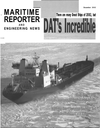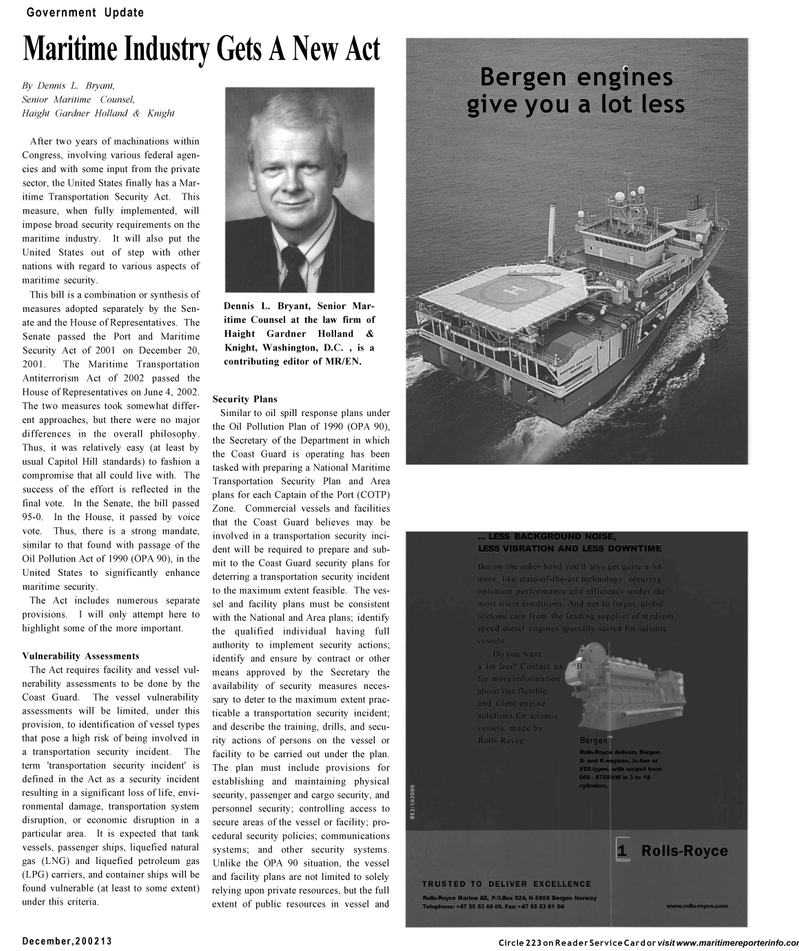
Page 13: of Maritime Reporter Magazine (December 2002)
Read this page in Pdf, Flash or Html5 edition of December 2002 Maritime Reporter Magazine
Government Update cylinders.
Dennis L. Bryant, Senior Mar- itime Counsel at the law firm of
Haight Gardner Holland &
Knight, Washington, D.C. , is a contributing editor of MR/EN.
Circle 223 on Reader Service Card or visit www.maritimereporterinfo.com 1 Rolls-Royce
TRUSTED TO DELIVER EXCELLENCE
Maritime Industry Gets A New Act
But on the other hand you'll also get quite a lot more, like state-of-the-art technology, securing optimum performance and efficiency under the most silent conditions. And not to forget, global lifelong care from the leading supplier of medium speed diesel engines specially suited for seismic vessels.
Do you want r m a lot less? Contact us ^B for more information about our flexible and silent engine solutions for seismic vessels, made by
Rolls-Royce. Bergen
Rolls-Royce delivers Bergen
B- and K-engines, In-line or
VEE-types, with output from 600 - 8750 kW in 3 to 18
Rolls-Royce Marine AS, P.O.Box 924, N-5808 Bergen Norway
Telephone: +47 55 53 60 00. Fax: +47 55 53 61 04 www.rolls-royce.com
By Dennis L. Bryant,
Senior Maritime Counsel,
Haight Gardner Holland & Knight
After two years of machinations within
Congress, involving various federal agen- cies and with some input from the private sector, the United States finally has a Mar- itime Transportation Security Act. This measure, when fully implemented, will impose broad security requirements on the maritime industry. It will also put the
United States out of step with other nations with regard to various aspects of maritime security.
This bill is a combination or synthesis of measures adopted separately by the Sen- ate and the House of Representatives. The
Senate passed the Port and Maritime
Security Act of 2001 on December 20, 2001. The Maritime Transportation
Antiterrorism Act of 2002 passed the
House of Representatives on June 4, 2002.
The two measures took somewhat differ- ent approaches, but there were no major differences in the overall philosophy.
Thus, it was relatively easy (at least by usual Capitol Hill standards) to fashion a compromise that all could live with. The success of the effort is reflected in the final vote. In the Senate, the bill passed 95-0. In the House, it passed by voice vote. Thus, there is a strong mandate, similar to that found with passage of the
Oil Pollution Act of 1990 (OPA 90), in the
United States to significantly enhance maritime security.
The Act includes numerous separate provisions. I will only attempt here to highlight some of the more important.
Vulnerability Assessments
The Act requires facility and vessel vul- nerability assessments to be done by the
Coast Guard. The vessel vulnerability assessments will be limited, under this provision, to identification of vessel types that pose a high risk of being involved in a transportation security incident. The term 'transportation security incident' is defined in the Act as a security incident resulting in a significant loss of life, envi- ronmental damage, transportation system disruption, or economic disruption in a particular area. It is expected that tank vessels, passenger ships, liquefied natural gas (LNG) and liquefied petroleum gas (LPG) carriers, and container ships will be found vulnerable (at least to some extent) under this criteria.
December, 2002 13 ... LESS BACKGROUND NOISE,
LESS VIBRATION AND LESS DOWNTIME
Security Plans
Similar to oil spill response plans under the Oil Pollution Plan of 1990 (OPA 90), the Secretary of the Department in which the Coast Guard is operating has been tasked with preparing a National Maritime
Transportation Security Plan and Area plans for each Captain of the Port (COTP)
Zone. Commercial vessels and facilities that the Coast Guard believes may be involved in a transportation security inci- dent will be required to prepare and sub- mit to the Coast Guard security plans for deterring a transportation security incident to the maximum extent feasible. The ves- sel and facility plans must be consistent with the National and Area plans; identify the qualified individual having full authority to implement security actions; identify and ensure by contract or other means approved by the Secretary the availability of security measures neces- sary to deter to the maximum extent prac- ticable a transportation security incident; and describe the training, drills, and secu- rity actions of persons on the vessel or facility to be carried out under the plan.
The plan must include provisions for establishing and maintaining physical security, passenger and cargo security, and personnel security; controlling access to secure areas of the vessel or facility; pro- cedural security policies; communications systems; and other security systems.
Unlike the OPA 90 situation, the vessel and facility plans are not limited to solely relying upon private resources, but the full extent of public resources in vessel and
Bergen engines give you a lot less

 12
12

 14
14
